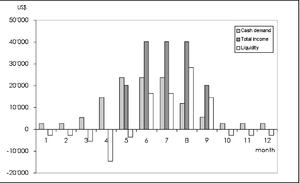Yuvraj Singh
From Wikipedia, the free encyclopedia
 | ||||
| Personal information | ||||
|---|---|---|---|---|
| Born | 12 December 1981 Chandigarh, India | |||
| Nickname | Yuvi | |||
| Height | 1.88 m (6 ft 2 in) | |||
| Batting style | Left-handed | |||
| Bowling style | Slow left arm orthodox | |||
| Role | Batsman | |||
| Relations | Yograj Singh (father) | |||
| International information | ||||
| National side | India | |||
| Test debut (cap 247) | 16 October 2003 v New Zealand | |||
| Last Test | 2 December 2009 v Sri Lanka | |||
| ODI debut (cap 134) | 3 October 2000 v Kenya | |||
| Last ODI | 5 January 2010 v Sri Lanka | |||
| Domestic team information | ||||
| Years | Team | |||
| 1996/97–present | Punjab | |||
| 2003 | Yorkshire | |||
| 2008–present | Kings XI Punjab | |||
| Career statistics | ||||
| Competition | Test | ODIs | FC | List A |
| Matches | 33 | 250 | 89 | 317 |
| Runs scored | 1,582 | 7,345 | 5,348 | 9,491 |
| Batting average | 35.78 | 37.09 | 43.12 | 37.96 |
| 100s/50s | 3/8 | 12/43 | 16/25 | 16/56 |
| Top score | 169 | 139 | 209 | 172 |
| Balls bowled | 751 | 3,932 | 1,807 | 4,929 |
| Wickets | 8 | 82 | 19 | 114 |
| Bowling average | 53.87 | 40.88 | 51.36 | 36.45 |
| 5 wickets in innings | 0 | 0 | 0 | 0 |
| 10 wickets in match | 0 | 0 | 0 | n0 |
| Best bowling | 2/9 | 4/6 | 3/25 | 4/6 |
| Catches/stumpings | 30/– | 72/– | 88/– | 93/– |
| Source: Cricinfo, 2 June 2010 | ||||
Contents[hide] |
[edit] Early career
Yuvraj first came to attention when he captained the U-19 Punjab cricket team in the final of the Cooch-Behar Trophy against Bihar U-19s, in which he scored 358.[3] He then gained selection for the U-19 World Cup in Sri Lanka in January 2000, where he was part of a team lead by Mohammed Kaif which won the tournament.[4] Yuvraj was subsequently selected in 2000 for the first intake of the National Cricket Academy in Bangalore.[5][edit] ODI career
Yuvraj made his One Day International debut against Kenya at Nairobi in 2000, at the ICC KnockOut Trophy. He showed his potential in his second ODI which was against the Australians where he scored a quickfire 84 off 82 balls against a quality pace attack consisting of bowlers like Glenn McGrath, Brett Lee and Jason Gillespie.[6] However, after a lean run of form, he was dropped for the one-dayers against Australia in India in early 2001,[7] but returned later in the year and helped India to victory in a match in Sri Lanka with an unbeaten 98.[8]One of his most memorable innings was a partnership with Mohammad Kaif in the NatWest Series final against England in July 2002 which led India to victory.[9] He was selected and represented India at the 2003 Cricket World Cup. He scored his first century in his fourth season with the Indian team against Bangladesh in 2003. After that he also scored hundreds against Zimbabwe and Australia, including a 139 off 119 balls at the Sydney Cricket Ground.[10] In the Indian Oil Cup 2005, he made 110 (off 114 balls) (his third century) and an important partnership worth 165 runs with Mohammad Kaif, to become the man of the match against West Indies in the last match of the round robin league. After reaching his century, he attracted attention by angry gesticulations to the Indian dressing room, which was postulated to be due to his clashes with team management - Greg Chappell had been appointed as the new Indian coach and he had criticised Yuvraj.[11] He later praised Chappell's techniques.[12]
Yuvraj had a good run of form late in 2005 and early in 2006, in the ODI format of the game. He was named as the man of the series in three consecutive series, against South Africa (joint with Graeme Smith),[13] and then against Pakistan and England, in which he scored three centuries and four half-centuries in fifteen matches, which propelled him into the top ten of the ICC ODI batting rankings. During the Pakistan tour, at times when captain and vice-captain Rahul Dravid and Virender Sehwag were absent, Yuvraj was the on-field captain, indicating that he may be seen as a potential captain.[11] In the next series in the West Indies, Yuvraj hit two fifties in four games, even though India lost the series 4-1. His performance was recognised with his shortlisting by the ICC as one of four nominees for the Internation One Day player of the year award.
Yuvraj missed the first game in the series after that, the tri-series against Australia and West Indies in Kuala Lumpur, due to illness and after failing to reach double figures in the following two games, was axed for Mohammed Kaif in the last group match. He showed signs of returning to form in the Champions Trophy, hitting a restrained unbeaten 27 to guide India to victory against England in the opening game after he was recalled in place of Kaif, but a knee injury forced him out of the final group match. He subsequently missed the tour of South Africa and was in doubt for the 2007 Cricket World Cup, but made a faster than expected recovery to play in the ODI series against the West Indies in India in January 2007. He struck a fluent 95* from 83 balls in India's final match against Sri Lanka before heading to the World Cup.
At the World Cup, Yuvraj only managed one fifty against a lowly Bermuda and along with rest of the squad, was criticized for India's first-round exit. Nevertheless, Yuvraj kept his place in the side for the tours of Bangladesh and Ireland in 2007.
In September 2007, he was named as the ODI vice captain of Mahendra Singh Dhoni after the resignation of Rahul Dravid. He then scored 121 in a losing cause during India's One-day International series defeat at the hands of Australia before enjoying a return to form as India beat Pakistan 3-2 on home soil in November 2007 and he was named Man of the series. In the five matches, he scored four half-centuries, although he was fined after showing dissent in the final match in Jaipur.[14]
In November 2008, he hit 138* from 78 balls against England at Rajkot, taking 64 balls to reach his century, which at the time was the second fastest by an Indian in ODIs, after Mohammad Azharuddin's century in 1988 against New Zealand came off 62 balls. After reaching 50 from 42 balls, he added a further 88 in the next 36 balls. He did so despite straining his back, which necessitated the use of Gautam Gambhir as a runner.[15] This was followed by 118 from 122 balls and a 4/28—all his wickets being specialist batsmen—in the next match in Indore, earning him two consecutive man of the match awards.[16]
[edit] Test career
Yuvraj made his Test debut against New Zealand in Mohali in late 2003 in front of his home crowd in Punjab due to the absence of regular captain Sourav Ganguly in the No. 6 position.[10] He was omitted upon Ganguly's return but got another opportunity in the Test team in the 2004 Tour to Pakistan, when Ganguly was again injured. He scored his first Test century in a losing effort against Pakistan in the second Test at Lahore. When Ganguly returned for the third Test, Akash Chopra was dropped and it appeared that the Indian selectors wanted to give him a regular place in the team. He was subsequently played as Virender Sehwag's opening partner, but after two poor matches in the Border-Gavaskar Trophy against Australia,[17] he was dropped in favour of Gautam Gambhir. He was recalled to the Test team, batting in the No. 6 position for the away series against Zimbabwe in August 2005 after Sachin Tendulkar was sidelined with tennis elbow. He then retained his position in the Test team after Ganguly was axed following a row with coach Greg Chappell. He scored a second Test century in the third and final Test in Pakistan in the series in January 2006, which India again lost. However, Yuvraj has struggled subsequently in 2006, failing to pass 50 in six Tests against England (two, both at home) and the West Indies (four, all away from home). His injury in late 2006 allowed the return of former captain Ganguly to the team, who subsequently top-scored in the series.
Yuvraj was included in India's Test squad to face Pakistan in November 2007, but was not included in the playing 11 for the first test. Yuvraj was picked in the 3rd Test due to an injured Sachin Tendulkar. India were 61/4 before he and Sourav Ganguly made a 300 run partnership with Yuvraj recording his highest Test score of 169.
He had a very poor Test series against Australia in Indian tour to that country in 2007–08. After his poor showing in the first two Tests he was dropped for the remainder of the series.
Yuvraj scored 85* put on an unbroken partnership of 163 with Sachin Tendulkar to defeat England in the First Test at Chennai on 15 December 2008. It was the fourth highest successful run chase in history and the highest in India.
[edit] Twenty20 career
On 19 September 2007 against England in the ICC World Twenty20 Super 8 match held at Kingsmead in Durban, he hit 6 sixes in an over up against Stuart Broad. This helped him to reach the fastest fifty ever in Twenty20 game, off just 12 balls and also the fastest in any form of international cricket.[18][19][20] This was the fourth time that six sixes had been hit in one over in senior cricket, the first time in Twenty20 cricket, and the first time in any form of international cricket against a bowler from a test playing nation. (Garfield Sobers and Ravi Shastri did it in first class matches, and Herschelle Gibbs did it in a 2007 Cricket World Cup match against Dutch bowler Daan van Bunge.) He has also hit the longest six of the tournament:119 meters off of Australian bowler Brett Lee and currently is the world's leading 20-20 batsman in terms of strike rate.[21] Yuvraj was awarded a Porsche 911 car for his 6 sixes achievement by the Vice President of the Board of Control for Cricket in India (BCCI), Lalit Modi. Yuvraj also received Rs.10,000,000 (US$252,716) in cash from the BCCI for his splendid performance in the tournament.[22]Yuvraj also scored 70 runs off 30 balls and went on to claim the Man of the Match against Australia in the World Twenty20 semifinals at Durban.[23]
He was the icon player and captain for Indian Premier League team Kings XI Punjab in the first two seasons; in 2010, the third season, icon player status was abolished and the captaincy given to Kumar Sangakkara. They came second in the round robin phase of the tournament, but lost their semi-final to the Chennai Super Kings. On 1 May 2009, Yuvraj picked up his first hat-trick in T20 cricket against Royal Challengers Bangalore at Kingsmead in Durban, the same ground where he hit his six sixes. He dismissed Robin Uthappa, Mark Boucher and Jacques Kallis. On 17 May 2009, Yuvraj picked up his second Twenty20 hat-trick against Deccan Chargers at the Wanderers Stadium in Johannesburg. Yuvraj dismissed Herschelle Gibbs, Andrew Symonds and Venugopal Rao.
[edit] Style
Yuvraj is primarily a left-handed batsman but can bowl part-time left-arm orthodox spin. He is regarded as being better at batting against fast bowling than spin bowling, and cites the Indian Oil Cup 2005 as a turning point in his career.[24] He is one of the better fielders in the Indian team, fielding primarily at point, with a good aim at the stumps. A Cricinfo report published in late 2005 showed that since 1999, he was the fourth most prolific fielder in effecting ODI run outs, and of those on the list of prolific fielders, he had the second highest rate of effecting a run out.[25] He was previously often characterized as having attitude problems,[26] but later often assumed leadership positions during Rahul Dravid's tenure as captain. Lately Yuvraj has put on a significant amount of weight, which has had an adverse effect on his fielding capability.[edit] Test Centuries
| Yuvraj Singh's Test Centuries | ||||||
|---|---|---|---|---|---|---|
| Runs | Match | Against | City/Country | Venue | Year | |
| [1] | 112 | 3 | Pakistan | Lahore, Pakistan | Gaddafi Stadium | 2004 |
| [2] | 122 | 13 | Pakistan | Karachi, Pakistan | National Stadium | 2006 |
| [3] | 169 | 20 | Pakistan | Bangalore, India | M.Chinnaswamy Stadium | 2007 |
[edit] County cricket
After the 2003 Cricket World Cup, Yuvraj was signed by Yorkshire, becoming only the second Indian after Tendulkar to represent the county.[3] However, he had a disappointing run, scoring less than 200 runs in either form of the game,[4] but described it as an important learning experience.[edit] Commercial interests
Yuvraj was signed by Microsoft to be a brand ambassador for the Xbox 360 video game console when it was launched in India in 2006. He appeared in advertisements for the console alongside Bollywood actor Akshay Kumar. Codemasters' cricket video game Brian Lara International Cricket 2007, was released with his endorsement in India, titled "Yuvraj Singh International Cricket 2007"[5] The Bollywood animated film, Jumbo features cricketer Yuvraj Singh's voice therefore starting his career in Bollywood. The upcoming animated full length feature film Captain India features Yuvraj Singh as the main protagonist.[27][28][29][30][edit] References
- ^ Chaitanya, Tanya (2005-02-23). "‘Mandira oye! Yuvraj Singh thinks being a cricket commentator is serious business". The Times of India (The Times of India). http://timesofindia.indiatimes.com/city/kanpur-times/Mandira-oye/articleshow/1030074.cms. Retrieved 2010-02-17.
- ^ "Yograj Singh". IMDB. http://www.imdb.com/name/nm1127958/bio. Retrieved 2007-02-05.
- ^ http://www.icc-cricket.com/india/content/story/79062.html
- ^ Vasu, Anand (2000-01-28). "Indian youth bring World Cup to India". Cricinfo. http://content-usa.cricinfo.com/ci/content/story/88206.html. Retrieved 2007-02-05.
- ^ Ramchand, Partab (2000-04-15). "First list of NCA trainees". Cricinfo. http://feedsuk.cricinfo.com/link_to_database/ARCHIVE/CRICKET_NEWS/2000/APR/029816_CI_15APR2000.html. Retrieved 2007-02-08.
- ^ "Aussies sunk by inspired India". BBC. 2000-10-07. http://news.bbc.co.uk/sport2/hi/cricket/961034.stm. Retrieved 2007-02-05.
- ^ "Harbhajan handed one day recall". BBC. 2001-03-28. http://news.bbc.co.uk/sport2/hi/in_depth/2001/india_v_australia/1228420.stm. Retrieved 2007-02-07.
- ^ Austin, Charlie (2001-08-01). "Yuvraj stars for India with match winning knock". Cricinfo. http://content-aus.cricinfo.com/ci/content/story/95752.html. Retrieved 2007-02-05.
- ^ "Hero Kaif takes India home". BBC News. 2002-07-13. http://news.bbc.co.uk/sport2/hi/cricket/england/2126684.stm.
- ^ a b Cricinfo - Gearing up without Ganguly
- ^ a b Cricinfo - Born again
- ^ Cricinfo - Yuvraj backs Chappell's methods
- ^ [1][dead link]
- ^ Yuvraj Singh Fined For Dissent After Jaipur Match, Cricket World, Retrieved on 19 November 2007
- ^ [2]
- ^ Yuvraj reigns over England again
- ^ Cricinfo - Singh hits a low note
- ^ Twenty20 matches-Fastest fifties
- ^ One-Day Internationals-Fastest fifties
- ^ Test matches-Fastest fifties
- ^ "Twenty20 Internationals - Highest career strike rate". http://stats.cricinfo.com/records/content/records/282920.html. Retrieved 2008-06-17.
- ^ World Champions arrives, Mumbai comes to standstill
- ^ http://sify.com/news/fullstory.php?id=14531778
- ^ Vasu, Anand. "Born again". Cricinfo. http://content-aus.cricinfo.com/ci/content/story/249085.html. Retrieved 2007-02-05.
- ^ Basevi, Trevor (2005-11-08). "Statistics - Run outs in ODIs". http://content-usa.cricinfo.com/ci/content/story/224487.html. Retrieved 2007-02-05.
- ^ "Yuvraj speaks highly of Sourav's support". Cricinfo. 2001-03-28. http://content-aus.cricinfo.com/ci/content/story/105607.html. Retrieved 2007-02-05.
- ^ "A wonder stick for Yuvi". Livemint.com - The Wall Street Journal. 7 April 2010. http://www.livemint.com/2010/04/07211054/A-wonder-stick-for-Yuvi.html?h=C. Retrieved 24 April 2010.
- ^ "Yuvraj Singh steps into glam world". One India. 7 April 2010. http://entertainment.oneindia.in/bollywood/news/2010/yuvraj-captain-india-070410.html. Retrieved 24 April 2010.
- ^ "Yuvraj Singh to star in an animated movie!". Indiainfo.com. 8 April 2010. http://movies.indiainfo.com/article/yuvraj-singh-to-star-in-an-animated-movie-852930/1042306.html. Retrieved 24 April 2010.
- ^ "Yuvraj Singh stars in animation flick, Captain India". Sify Movies. 9 April 2010. http://sify.com/movies/fullstory.php?id=14938051. Retrieved 24 April 2010.

































